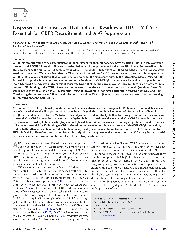摘要
CBF beta was recently found to be a key regulator of the ability of human immunodeficiency virus type 1 (HIV-1) Vif to overcome host antiviral APOBEC3 proteins. However, the detailed molecular requirements for the Vif-CBF beta interaction are still not clear. Here, we mapped the minimum Vif domain required for CBF beta binding. In terms of CBF beta binding, the Vif N terminus was very sensitive to deletions. We determined that the Vif fragment from residues 5 to 126 was sufficient to form a stable complex with CBF beta in vitro. We also observed that ionic interactions were not the main contributor to the interaction between Vif and CBF beta. Instead, hydrophobic interactions were important for maintaining the Vif-CBF beta complex, since it could be disrupted by nonionic detergent. Site-directed mutagenesis of conserved hydrophobic amino acids revealed novel residues in Vif that were important for CBF beta binding and APOBEC3 inactivation. At least part of the well-characterized HCCH domain (residues 108 to 139) was required to form a stable Vif-CBF beta complex. Thus, the HCCH motif may have a dual role in binding both Cul5 and CBF beta. Considering the importance of Vif in HIV-1 infection, this unique Vif-CBF beta interaction represents an attractive pharmacological intervention target against HIV-1. @@@ IMPORTANCE @@@ Vif-induced APOBEC3 protein degradation was the first host antiviral mechanism against HIV-1/simian immunodeficiency virus to be revealed, yet details regarding which proteins are degraded are not fully demonstrated. Recently, host cellular factor CBF beta was found to be essential for Vif to function and promote viral infectivity. In this study, we present more critical information on the Vif-CBF beta interaction by revealing that hydrophobicity contributes the most to the Vif-CBF beta interaction and locating several novel hydrophobic sites (tryptophans and phenylalanines) that are conserved among Vif proteins from different lentiviruses and essential for Vif binding to CBF beta. Mutations on these sites result in a reduced/abolished Vif-CBF beta interaction, leading to the attenuated potency of Vif on both inducing the degradation of antiviral factors like APOBEC3G and promoting HIV-1 infectivity. Therefore, information from this study will help people to further understand how Vif acts against host antiviral mechanism, which is important for novel anti-HIV-1 drug development.
